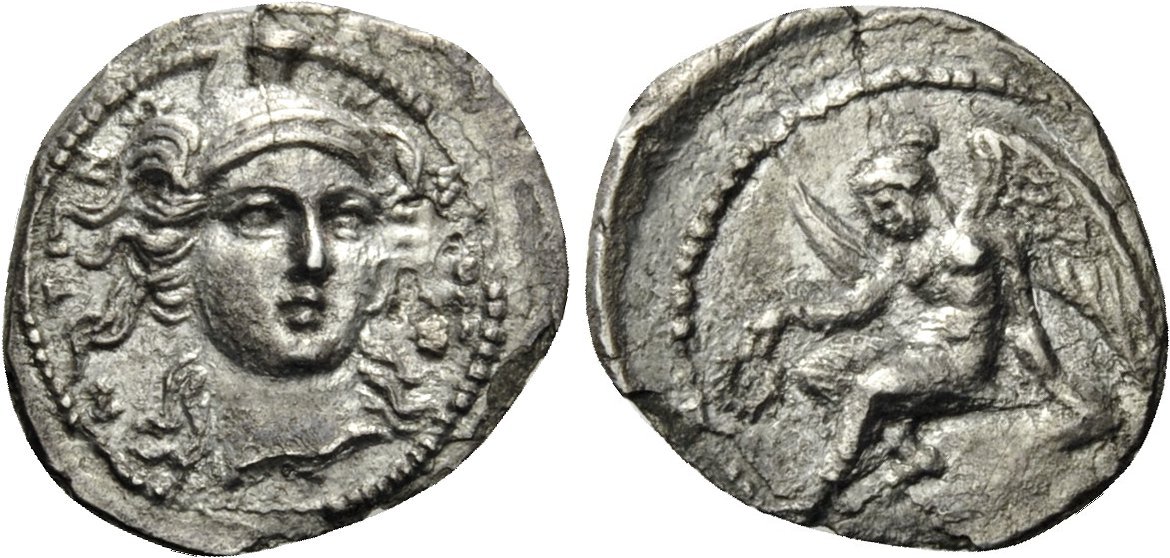Morgantina, silver, 1/4 litrai (344-317 BCE)
From SILVER
339 BCE - 317 BCE Silver 113 kg
Description
| ObverseInscription or printing placed on the obverse.: | MOPΓANTINΩN (Greek).Head of Athena three quarter right, wearing helmet. Bordre of dots. |
| ReverseInscription or printing placed on the reverse.: | MOPΓANTINΩN (Greek).Nike, her wings spread, seated left on a boulder, holding a wreath in her right hand and resting her left on the rock |
Mint and issuing power
| MintIdentifies the place of manufacture or issue of a numismatic object.: | Morgantina | Ancient regionAncient region.: | Sicily | Modern countryModern country: Italy | AuthorityIdentifies the issuing power. The authority can be "pretended" when the name or the portrait of X is on the coin but he/she was not the issuing power. It can also be "uncertain" when there is no mention of X on the coin but he/she was the issuing power according to the historical sources: |
Chronology
| FromIdentifies the initial date in a range assigned in a numismatic context. | 339 BCE | toIdentifies the final date in a range assigned in a numismatic context.. | 317 BCE | PeriodTime period of the numismatic object.: Classical and Hellenistic |
Physical description
| MetalThe physical material (usually metal) from which an object is made.: | Silver |
Median weightMedian of the weights of numismatic objects (in grams). in grams | 1.05 | DenominationTerm indicating the value of a numismatic object. Examples: tetradrachm, chalkous, denarius.: | 1/4 litra | StandardStandard.: |
Image

H 30 - Morgantina, silver, 1-4 litra, 344-317 BC.jpg [1]
References
| Die study referencePublication of the study: | Buttrey 19891Buttrey 1989, Group III, A (3) | ||
| Coin series referenceReference to coin series study: | RQEMH2RQEMH, n° 30, Sear I3Sear I, n° 859, HGC 24HGC 2, n° 896 | ||
| Coin series web referenceCoin series web references: | |||
Obverse dies distribution
| FrequencyFrequency of specimen in distribution. ᵖ | Number of obversesNumber of obverse dies. ᵖ (o) | % (o) | Number of coinsNumber of coins. (n) | % (n) | Die nameName(s) of the die(s). |
| 1 | 2 | 40 | 2 | 6.45 | 4, 5 |
| 2 | 1 | 20 | 2 | 6.45 | 2 |
| 5 | 1 | 20 | 5 | 16.13 | 3 |
| 22 | 1 | 20 | 22 | 70.97 | 1 |
| Total | 5 of 5 | 100 | 31 of 31 | 100 |
Reverse dies distribution
no distribution is available
Quantification
| Number of obversesNumber of obverse dies. ᵖ (o) | 5 | Number of singletons (o1)The number of singleton coins. ᵖ | 2 |
| Number of reverse diesNumber of reverse dies. (r) | 5 | Number of coinsNumber of coins. (n) | 31 |
| Coins per obverse dieNumber of coins per obverse die. (n/o) | 6.2 | Coins per reverse dieNumber of coins per reverse die. (n/r) | 6.2 |
| Reverse per obverse ratioRatio of obverse dies divided by reverse dies. (r/o) | 1 | Percentage of singletons (o1)number of coins (n) divided by the number of singletons (o1) ᵖ | 40 % |
| Original number of dies (O) (Carter 1983 formula)The estimation of the number of coins according to Carter 1983 ᵖ | 5.36 | Coins struck if 20,000 as average productivity per dieCoins made if the average productivity for obverses (according to Carter) is 20,000. ᵖ | 107,200 |
| Original number of dies (O) (Esty 2011 formula)The estimation of the number of coins according to the singleton formula in Esty 2011 ᵖ (O) | 5.96 | Survival rate if 20,000 as average productivity per dieSurvival rate if average productivity is 20,000. ᵖ | 0.00029 |
| Coverage (o = % of O) (Esty 1984 formula)Esty 1984 - coverage (% of O) ᵖ (o = % of O) | 93.55% | Die productivity if survival rate 1/2,000Average productivity if survival rate is 1/2,000. ᵖ | 11,567.16 |
| Weight of silver (in kg) if 20,000 coins per die (O = Carter formula)Carter 1983 * Median weight * 20000 (*10 if gold or electrum) ᵖ | 113 kg <br /> 113 kg | Die productivity if survival rate 1/5,000Average productivity if survival rate is 1/5,000. ᵖ | 28,917.91 |
Remarks
Most likely one single workstation